Summary
Revista Brasileira de Ginecologia e Obstetrícia. 2020;42(1):26-34
To assess the construct and criterion validity of the Postmenopause Sexuality Questionnaire (PMSQ).
The present methodological questionnaire validation study included postmenopausal women. The construct validity was tested by factor analysis and the criterion validity was performed using the correlation between the PMSQ and the Female Sexual Function Index (FSFI). The ROC curve was used to verify sensitivity, specificity and to determine the cutoff point of the PMSQ.
A total of 181 women with amean age of 56.4 ± 5.7 years old were evaluated. The exploratory factor analysis showed that the PMSQ presented Kaiser test = 0.88 and χ2 = 3293.7 (p < 0.001), commonalities ≥ 0.5, and extraction of 9 factors with eigenvalue ≥ 1; explaining 66.3% of the total variance. The PMSQ presented factor loadings between 0.4 and 0.8. A strong correlation between the 2 questionnaires (r = 0.79; p = 0.000) was shown. The cutoff point of the PMSQ was ≤ 55.5, assuming 87.9% sensitivity and 78.9% specificity (p < 0.001).
Since the PMSQ showed a strong correlation with the FSFI questionnaire, it presented good psychometric properties to assess the sexuality in postmenopausal women. Based on these results, the PMSQ could be widely tested as a specific instrument to examine the sexual function in postmenopausal women. Future studies, designed to examine the PMSQ instrument in different populations, are needed.
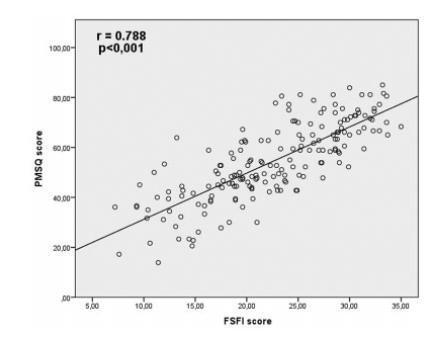
Summary
Revista Brasileira de Ginecologia e Obstetrícia. 2020;42(1):19-25
To explore the experiences of women with obesity regarding self-care and the care provided by their families and health team after childbirth.
A clinical qualitative study performed at the Postnatal Outpatient Clinic of Hospital da Mulher, Universidade Estadual de Campinas, Brazil. The sample was selected using the saturation criteria, with 16 women with obesity up to 6 months after childbirth.
The analysis comprised three categories: 1) postnatal self-care; 2) family support for woman after childbirth; and 3) postnatal health care service for women with obesity.
Women with obesity need support from the health team and from their families after childbirth, when they are overwhelmed by the exhausting care for the newborn. The present study reveals how important it is for health care professionals to broaden their perception and care provided after childbirth for women with obesity so they may experience an improvement in their quality of health and of life.
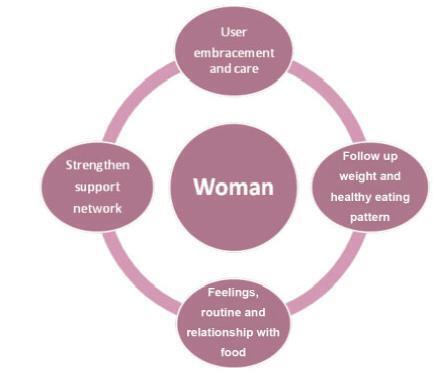
Summary
Revista Brasileira de Ginecologia e Obstetrícia. 2020;42(1):12-18
To assess the prevalence of gestational diabetes mellitus and the main associated risk factors in the population served by the Brazilian Unified Health System in the city of Caxias do Sul, state of Rio Grande do Sul.
A descriptive, cross-sectional and retrospective study was conducted. Maternal variables were collected from the medical records of all pregnant women treated at the basic health units in 2016. Hyperglycemia during pregnancy (pregestational diabetes, overt diabetes and gestational diabetes mellitus) was identified by analyzing the results of a 75-g oral glucose tolerance test, as recommended by the Brazilian Ministry of Health. Based on the data, the women were allocated into two groups: the gestational diabetes group and the no gestational diabetes group.
The estimated prevalence of gestational diabetes among 2,313 pregnant women was of 5.4% (95% confidence interval [95%CI]: 4.56-6.45). Pregnant women with 3 or more pregnancies had twice the odds of having gestational diabetes compared with primiparous women (odds ratio [OR]=2.19; 95%CI: 1.42-3.37; p<0.001). Pregnant women aged 35 years or older had three times the odds of having gestational diabetes when compared with younger women (OR=3.01; 95%CI: 1.97-4.61; p<0.001). Overweight pregnant women were 84% more likely to develop gestational diabetes than those with a body mass index lower than 25 kg/m2 (OR =1.84; 95%CI: 1.25-2.71; p=0.002). A multivariable regression analysis showed that being overweight and being 35 years old or older were independent variables.
In this population, the prevalence of gestational diabetes mellitus was of 5.4%. Age and being overweight were predictive factors for gestational diabetes.
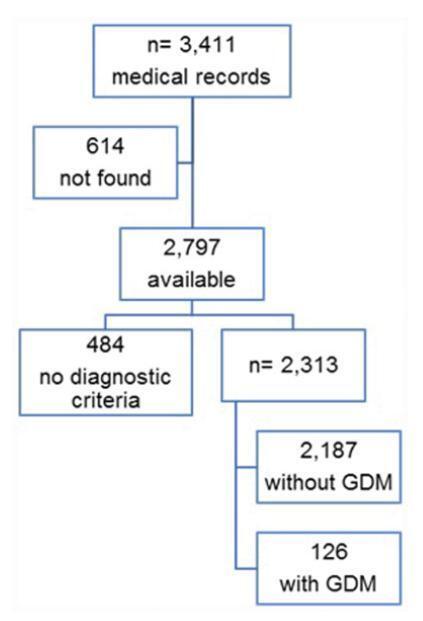
Summary
Revista Brasileira de Ginecologia e Obstetrícia. 2019;41(12):703-709
To investigate the action of testosterone (T), isolated or associated with estradiol benzoate (EB), on the proliferation markers and apoptosis of breasts of ovariectomized rats.
A total of 48 castrated female Wistar rats were divided into 6 groups, and each of them were submitted to one of the following treatments for 5 weeks: 1) control; 2) EB 50 mcg/day + T 50 mcg/day; 3) T 50mcg/day; 4) EB 50 mcg +T 300 mcg/day; 5) T 300 mcg/day; and 6) EB 50 mcg/day. After the treatment, the mammary tissue was submitted to a histological analysis and immunoexpression evaluation of proliferation markers (proliferating cell nuclear antigen, PCNA) and apoptosis (caspase-3).
There was a statistically significant difference among the groups regarding microcalcifications and secretory activity, with higher prevalence in the groups treated with EB. There was no difference among the groups regarding atrophy, but a higher prevalence of atrophy was found in the groups that received T versus those that received EB +T. There was a difference among the groups regarding the PCNA (p = 0.028), with higher expression in the group submitted to EB +T 300 mcg/day. Regarding caspase-3, there was no difference among the groups; however, in the group submitted to EB +T 300 mcg/day, the expression was higher than in the isolated T group.
Isolated T did not have a proliferative effect on the mammary tissue, contrary to EB. Testosterone in combination with EB may or may not decrease the proliferation, depending on the dose of T.
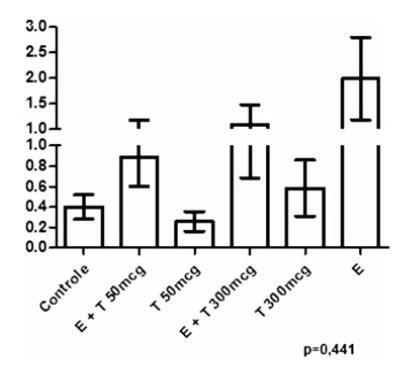
Summary
Revista Brasileira de Ginecologia e Obstetrícia. 2019;41(12):688-696
To evaluate the association between early-onset fetal growth restriction (FGR), late-onset FGR, small for gestational age (SGA) and adequate for gestational age (AGA) fetuses and adverse perinatal outcomes.
This was a retrospective longitudinal study in which 4 groups were evaluated: 1 - early-onset FGR (before 32 weeks) (n=20), 2 - late-onset FGR (at or after 32 weeks) (n=113), 3 - SGA (n=59), 4 - AGA (n=476). The Kaplan-Meier curve was used to compare the time from the diagnosis of FGR to birth. Logistic regression was used to determine the best predictors of adverse perinatal outcomes in fetuses with FGR and SGA.
A longer timebetween the diagnosis and birthwas observed forAGAthan for late FGR fetuses (p<0.001). The model including the type of FGR and the gestational age at birth was significant in predicting the risk of hospitalization in the neonatal intensive care unit (ICU) (p<0.001). The model including only the type of FGR predicted the risk of needing neonatal resuscitation (p<0.001), of respiratory distress (p<0.001), and of birth at<32, 34, and 37 weeks of gestation, respectively (p<0.001).
Fetal growth restriction and SGA were associated with adverse perinatal outcomes. The type of FGR at the moment of diagnosis was an independent variable to predict respiratory distress and the need for neonatal resuscitation. The model including both the type of FGR and the gestational age at birth predicted the risk of needing neonatal ICU hospitalization.
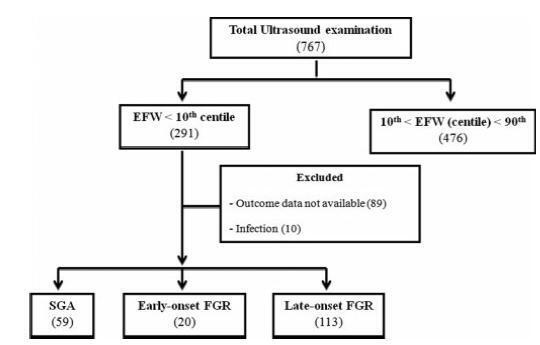
Summary
Revista Brasileira de Ginecologia e Obstetrícia. 2019;41(11):668-672
To analyze the effect of thalidomide on the progression of endometriotic lesions experimentally induced in rats and to characterize the pattern of cell proliferation by immunohistochemical Proliferating Cell Nuclear Antigen (PCNA) labeling of eutopic and ectopic endometrium.
Fifteen female Wistar rats underwent laparotomy for endometriosis induction by resection of one uterine horn, isolation of the endometrium and fixation of a tissue segment to the pelvic peritoneum. Four weeks after, the animals were divided into 3 groups: control (I), 10mg/kg/day (II) and 1mg/kg/day (III) intraperitoneal thalidomide for 10 days. The lesion was excised together with the opposite uterine horn for endometrial gland and stroma analysis. Eutopic and ectopic endometrial tissue was submitted to immunohistochemistry for analysis of cell proliferation by PCNA labeling and the cell proliferation index (CPI) was calculated as the number of labeled cells per 1,000 cells.
Group I showed a mean CPI of 0.248 ± 0.0513 in the gland and of 0.178 ± 0.046 in the stroma. In contrast, Groups II and III showed a significantly lower CPI, that is, 0.088 ± 0.009 and 0.080 ± 0.021 for the gland (p < 0.001) and 0.0945 ± 0.0066 and 0.075 ± 0.018 for the stroma (p < 0.001), respectively. Also, the mean lesion area of Group I was 69.2mm2, a significantly higher value compared with Group II (49.4mm2, p = 0.023) and Group III (48.6mm2, p = 0.006). No significant difference was observed between Groups II and III.
Thalidomide proved to be effective in reducing the lesion area and CPI of the experimental endometriosis implants both at the dose of 1mg/kg/day and at the dose of 10 mg/kg/day.
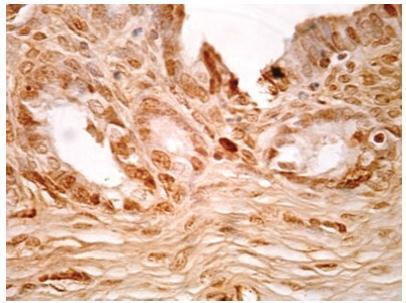
Summary
Revista Brasileira de Ginecologia e Obstetrícia. 2019;41(10):613-620
To evaluate the association between the acceptance on the part of the patients and their reasons to consent to or refuse medical student attendance during gynecological outpatient care, considering the participants’ demographic characteristics, consultation experience, and gender bias or lack thereof.
Face-to-face interviews with patients waiting for gynecological consultations that had been scheduled in advance at Hospital Universitário de Brasília. Contingency analyses were used to determine the levels of association among the patient variables. The accepted significance level was values of p<0.05.
We interviewed 469 patients. The comfort level with the presence of a student was strongly related to the number of students present during the consultation (Cramér V=0.671). The inclination to grant consent (a series of reasons to consent to or refuse student attendance) was significantly related (p<0.001) to the overall receptivity to student participation (ρ=0.482), the positive appraisal of student-doctor demeanor in previous consultations (ρ=0.253, N=408), and to greater levels of schooling (ρ=0.158). The patients’ receptivity was significantly related (p<0.001) to the lack of bias regarding the gender of the physician (CramérV=0.388), previous experience with students (Cramér V=0.235) and awareness of the fact that they would be present (Cramér V=0.217), older age (ρ=0.136, p=0.003), and multiparity (ρ=0.102, p=0.027).
Greater receptivity to student participation related significantly to five conditions in decreasing order of strength of association: lack of bias regarding the gender of the Ob-Gyn, previous experience with student involvement, awareness of the presence of students, older age, and multiparity. We also found that a more positive inclination to consent to student attendance correlated positively with a greater receptivity to student participation and to a suitable student-doctor demeanor.
Summary
Revista Brasileira de Ginecologia e Obstetrícia. 2019;41(10):607-612
Almost 80% of adolescent pregnancies are unplanned, and between 28 and 63% of adolescent mothers had a repeated pregnancy within 18 months. Among girls with repeated pregnancies, two-thirds reported that the pregnancy was unplanned. We aim to assess contraceptive use by adolescent mothers with increasing choice for long-acting reversible contraception (LARC) methods in postpartum consultation after a semistructured group intervention involving adolescent mothers.
Retrospective observational study conducted at the Universidade Estadual de Campinas, Campinas, state of São Paulo, Brazil, involving new antenatal and postpartum education groups for adolescents. At postpartum consultations, the adolescents chose their contraceptive. The datawas compared with previous series followed in a period before the implementation of the education group - a historical control group.
We included 129 adolescent after childbirth from January 1st, 2015 through July 31st, 2017. Out of this total, 63% had ever used contraceptive methods before pregnancy, and the most frequent method was combined oral contraceptives (33%) followed by condoms (21%). At the first postpartum consultation, the most common contraceptive chosen was intrauterine contraception (IUC) (37.2%) and depot-medroxyprogesterone acetate (DMPA) (34.1%).When comparing the rates before and after the education interventions, there was a 3-fold increase in the use of IUCs.
Antenatal and postpartum education have shown a significant increase in the choice for LARC methods among adolescent mothers, with very high acceptability after a period using the method. The educational groups performed during the antenatal care and beyond the gestational period are easy to be applied worldwide with low dependence on funding.
